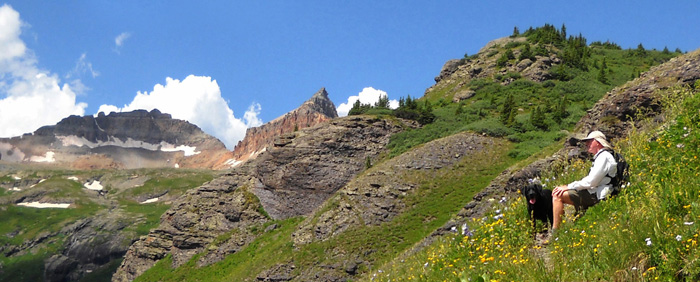The youngest of the three major U.S. military service academies, the Air Force Academy in northwestern Colorado Springs was
first opened to cadets in 1955. The site was chosen by a committee that
reviewed a whopping 582 sites proposed by 45 states.
I think they made a fine choice! This is a perfectly gorgeous
setting, truly a gem.
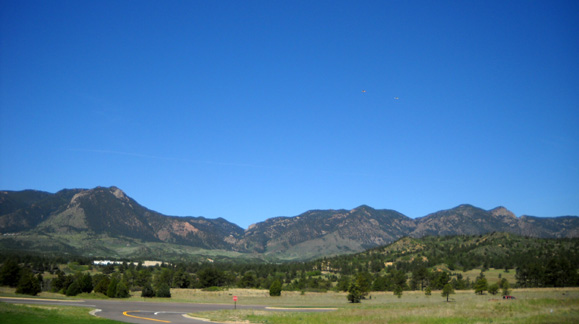
There were more criteria for the site than the ones I quoted above, of
course. The Air Force had many factors to consider, from very functional things like
availability of water and utilities, suitability for flight training, proximity
to transportation, and the cost of the land, to more esoteric
qualities like
cultural resources and a climate with four seasons.
Since it was built, the Air Force Academy has been popular with visitors, who are admitted with less
scrutiny than most military installations we've been to. Football games and
tours of the unique chapel, shown below, are two of the features that draw locals and tourists alike.
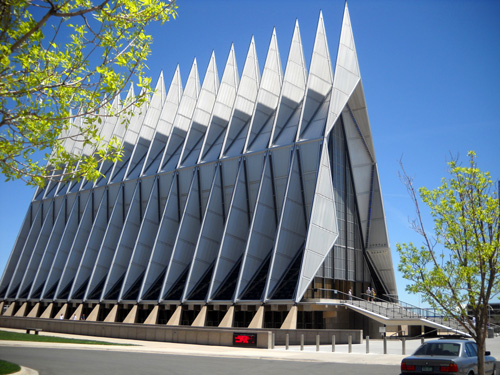
Here's an interesting story we heard regarding the public's interest in the
academy: when it held its first open house in the 1950s, a whopping
85,000 people showed up, reportedly causing the worst traffic jam in Colorado
history!
The security force soon learned how to better control large football and
graduation crowds.
Driving, running, cycling, and hiking around the huge 19,000-acre academy
-- which is part university, part military base --
gives one a true sense of the size of the place.
There are more acres of forested land and meadows than acres
that have been developed. In fact, it's like being in a nature
preserve. There are numerous deer, grey fox, coyotes, and those
devilish-looking black Albert squirrels (with long, pointed
ears) running around the place. Very cool.
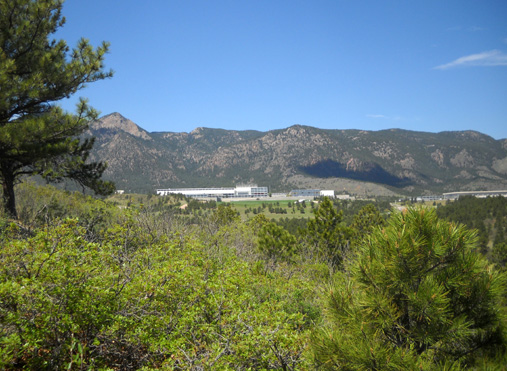
Distant view of the Cadet Area from a ridge
on the Falcon Loop Trail
Jim and I have toured both West Point and Annapolis, our
country's Army and Navy military academies, but we spent only a
few hours at each of them, a much shorter time than the eleven days
we'll be at the Air Force Academy. Even though this institution
doesn't have the lengthy history or the
traditional architecture of those "other" academies, I feel more
at home at this one. I've already joked to Jim that I'd like to
live here -- not just the Colorado Springs area, but on
base! Hanging out for several days in the FamCamp on this beautiful
campus and watching the ebb and flow of the activities here
makes a difference.
So does the location at the edge of the mountains. You know how
I love mountains.
The USAFA rocks!
We've both really enjoyed exploring the academy grounds and learning
more about the history of the place, the architecture, details
about the cadet program, the high expectations for these future
leaders, how and why the falcon mascot was chosen, and other
interesting facts we learned from various sources --
folks who live and work on base, the visitor center, other
informative exhibits all over the place, publications we picked
up, the USAFA
website, and a PBS special
about the academy entitled "Jewel of the Rockies."
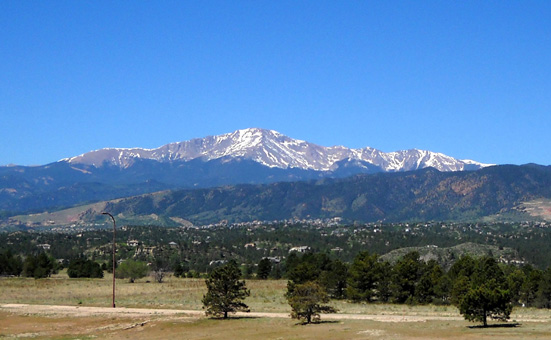
View of Pike's Peak from the southern part
of the Academy
In this entry I'll give an overview of the academy from a
visitor's perspective, including the impressive visitor center,
distinctive chapel, Cadet Area, A-10 Warthog display,
and campground.
In subsequent entries I'll show photos from the 2010 cadet
graduation ceremony in the Falcon Stadium, the Thunderbird air
show and practice, and the multi-use trail system.
VISITING THE ACADEMY
Public access to the academy is more generous than most military
bases or posts. Visitors may enter the north or south gates with
only a valid driver's license but they may be subject to
other random security measures like a vehicle inspection. Jim
and I just show the guards our retired military IDs.
Visitors may access some but not all of the base: several
overlooks along the roads on base, the Visitor
Center, Cadet Chapel, Falcon Stadium, Falcon Athletic Center,
Cadet Field House, Arnold Hall Student Center, Honor Court, A-10 Warthog
display, and Associates of Graduates Building. Jim and I are
also able to access the BX, Commissary, gas station, gym,
campground, and other facilities open to military retirees.
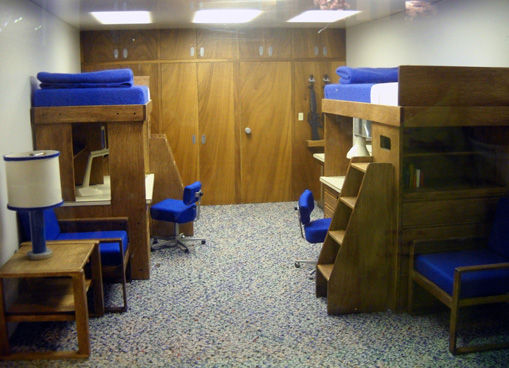
Most
visitors may not access the housing areas (Cadet Area and
Douglass Drive), the Terrazzo, and the airfield. Since the
public is not allowed to see the dormitories, a typical room is
displayed in the visitor center (above).
You can read more about visiting the academy
here. If you're in the Colorado
Springs area, we highly recommend dropping in for a few hours to
learn more about this fascinating institution.
VISITOR CENTER
The best place for first-time visitors to go first is the
well-designed visitor center, which is nestled among the
foothills on the far western side of the base near the Cadet
Area.
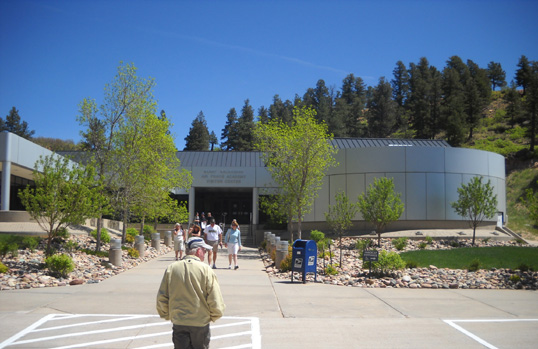
The bright, spacious building is full of historical data about
the academy and a good place to learn about life as a cadet.
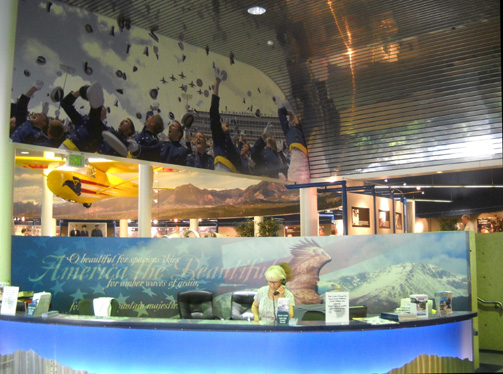
We watched a series of short videos in a small auditorium
within the visitors' center. The films answered many of our questions about the history of the
Academy and the cadets' training.
Until touring the Academy I didn't realize that women were not
allowed in any of our military academies until President
Gerald Ford signed legislation in 1975 allowing them to attend
cadet training to become officers. Although it doesn't seem all
that controversial today (to me, at least!), it was
controversial at the time. Women first entered the USAFA in 1976;
they are an integral part of the institution today.
You can read more about the Academy's history at this
link.
Admission to any of the service academies is tough. The Air
Force is no different. Per the
admissions web page, the
approximate 1,000+ cadets who are chosen each year are the ones
who will most likely successfully complete the Academy's broad
program of intellectual, professional, physical, and character
development in order to "become tomorrow's air and space
leaders."
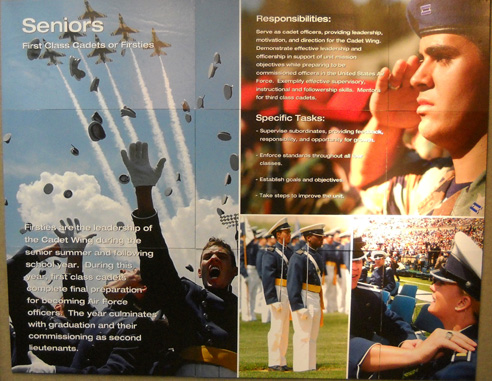
Cadets graduate with a four-year degree in one of twenty-five
areas of study that will be useful in their careers as Air Force
officers. The majority major in science and engineering but they
are exposed to a broad curriculum that includes the humanities
and social sciences also. In addition to a Bachelor's Degree,
cadets graduate with a commission as Second Lieutenant --
and a commitment to a minimum number of years of military
service.
In a non-military college or university, the students' main
focus is usually on academics -- unless they are on an
athletic scholarship or are party animals! At the Air Force
Academy, academics are only one part of their experience. They
must also participate in extensive military training and sports.
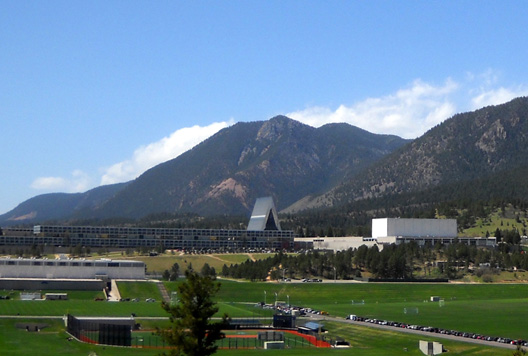
Some of the athletic fields in the Cadet
Area
Sports?
Yep! There is a very strong emphasis on physical fitness here.
Jim and I think that's great. Not only must cadets get and stay
in excellent physical shape, they also gain teamwork and
leadership skills through their athletic pursuits while at the
Academy. Extensive physical education, intramural sports, and
intercollegiate programs are offered.
Cadets also receive aerospace-oriented military education and
training throughout their four year stint at the Academy. They
are placed in as many leadership positions as possible in each
succeeding year they are at the Academy in order to prepare them
to be effective Air force officers.
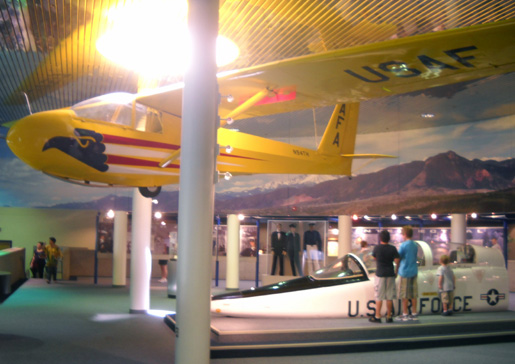
Cadets are kept so busy with
their military, academic, and athletic training during the four
years they spend at the academy that there is essentially no
time for pilot training -- qualified students who
want to become pilots pursue
further training after graduation. Cadets all take basic
classes in aviation, navigation, parachuting, and soaring in
gliders. Students in the flight screening program may fly light
aircraft with the Cadet Flying Team.
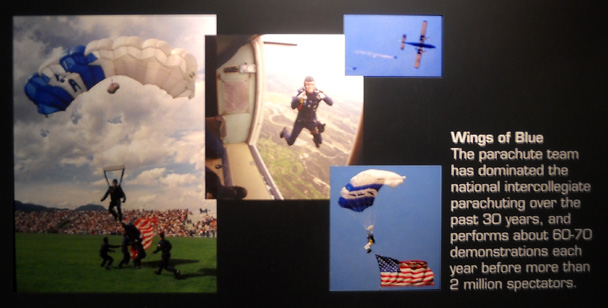
In their spare time (?!) cadets are also encouraged to
participate in extracurricular activities like forensics,
falconry, the drum and bugle corps, cadet honor guard,/rifle
team, parachute team, ski club, and the cadet chorale.
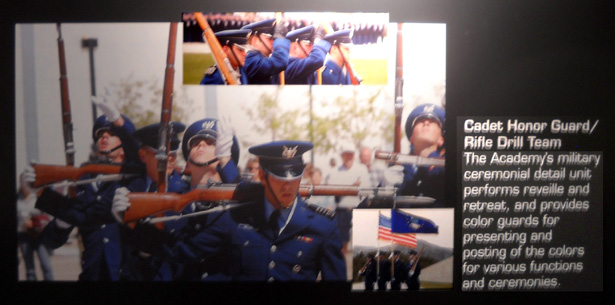
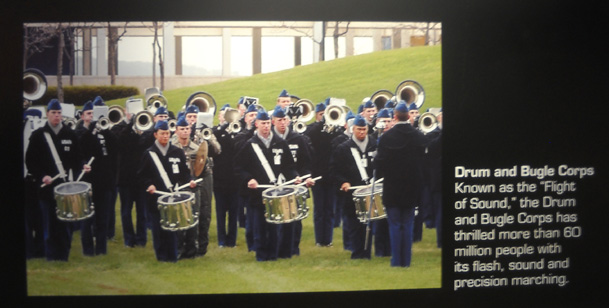
You can learn more about cadet training
here.
MODERN AIR FORCE, MODERN ARCHITECTURE
Admitting women to the academy was one of two major
controversies that I've read about in the Air Force Academy's
55-year history.
The other was the design chosen for the cadet chapel! It shocked
some people, yet it has been one of the main draws on the
academy grounds since it (the chapel) was finished in 1962. Now it's
considered a classic of modern architecture and people come to
see it from all over the world. The principal designer was
renowned architect Walter Netsch.
One of the signs at a parking area overlooking the Cadet Area
(dorms, classrooms, and chapel) explains the rationale for the
architecture that was chosen for this large complex to
house and train over 4,000 cadets:
The U.S. Air Force Academy was established in an era of atom
bombs, baby booms, and the Cold War. Public interest in it ran
high. Like West Point and Annapolis, the public thought of it as
a national memorial and its design needed to reflect that
expectation as well as the ultra-modern character of the Air
Force.
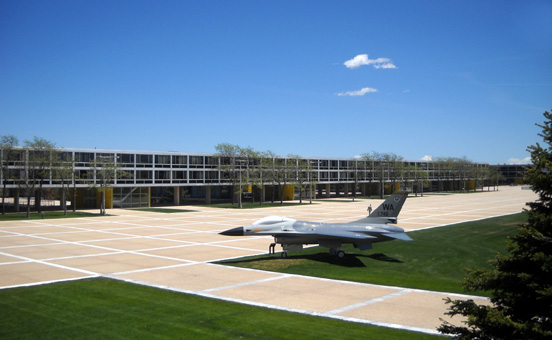
The Academy's design reflects the "modern movement" in
architecture, which featured clean, straight lines with minimal
decorative details, and favored structural steel and glass over
traditional building materials such as brick. The Academy's
modern architectural style, monumental scale, and inspiring
setting continue to work together to create our next generation
of Air Force leaders.
The Air Force chose designers that understood the desire for
sharp-lined, soaring structures to represent the newest,
swiftest military science.
The photo above and the next three below show several views of
the Cadet Area from the centrally-located cadet chapel:
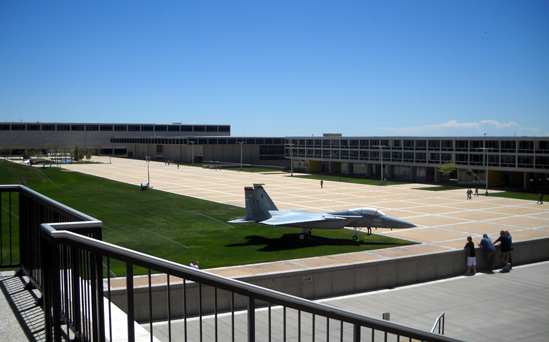
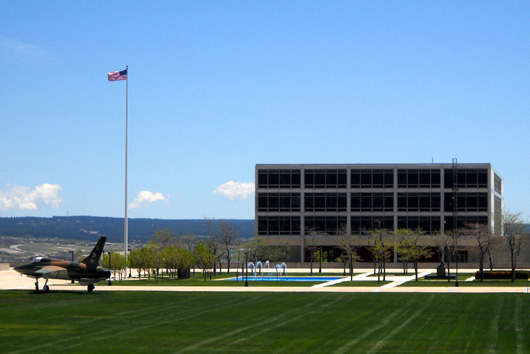
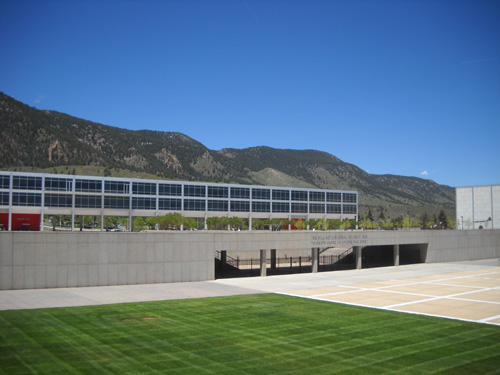
"We will not lie, steal, or cheat, nor
tolerate among us anyone who does."
The cadet honor code is chiseled in concrete in
the Cadet Area.
Although visitors may not wander around the cadet areas shown
above, they may enter the chapel from a nearby parking area or
by walking 1/3 of a mile along a hilly, paved trail from the
visitor center. The chapel is open to the public for self-guided
tours from 9 AM to 5 PM Monday to Saturday and 1-5 PM on Sunday.
Guided tours are also available at
certain times.
Worship services are also open to the public. Five diverse
faiths (Protestant, Catholic, Jewish, Buddhist, and
earth-centered) provide services in separate spaces within the
chapel. Each sanctuary has its own entry, so services can be
held simultaneously.
Even though I'd seen the chapel from a distance along the Falcon Loop
Trail and some of the overlooks, the chapel is pretty stunning
as you approach it closely on foot. Jim and I entered the upper
(Protestant) chapel via the broad stairs at the front of the
building, then walked to the lower level to see the other
chapels; disabled visitors may use an accessible
entrance on the ground floor to reach both levels..
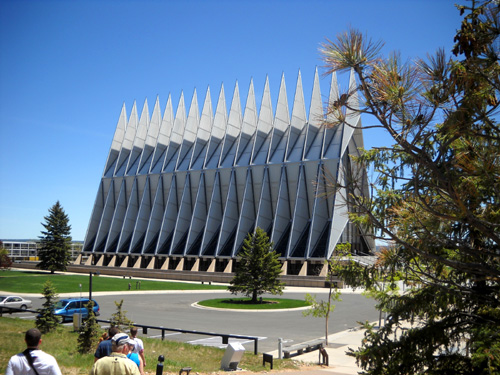
The materials used in the interior of the chapel are very
beautiful
and my pictures don't do them justice: stained
glass, glass mosaic, marble, mahogany, walnut, cedar, cherry,
ash, cypress, and other hardwoods, stones, and metals.
The entire upper floor of the chapel houses the large Protestant
sanctuary. Here are a few pictures of this colorful space:
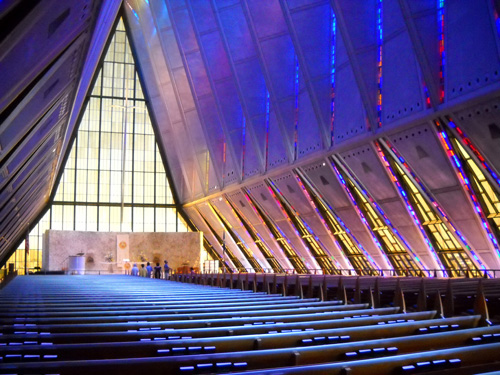
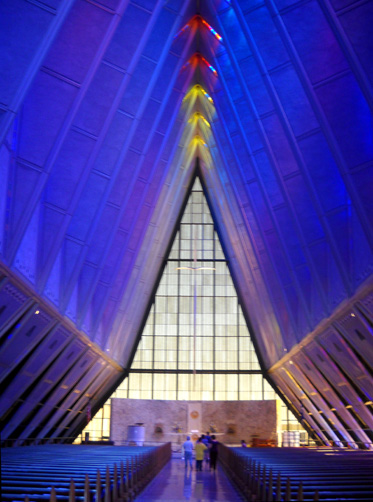
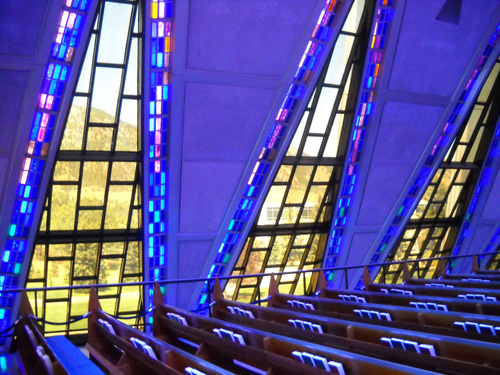
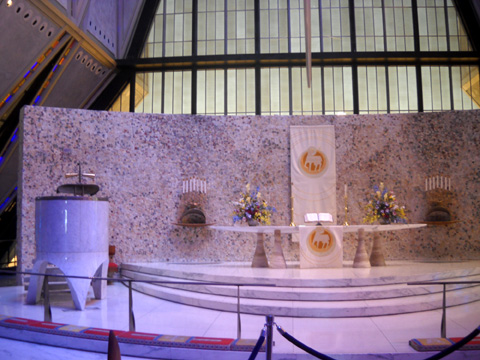
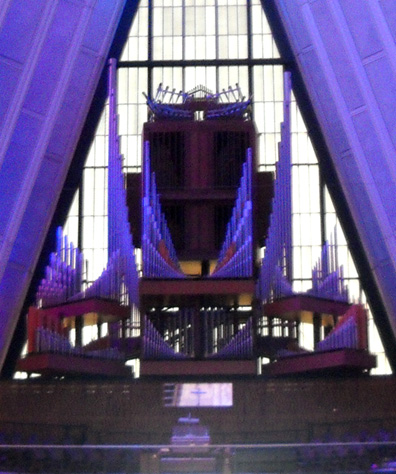
Huge organ with 4,334 pipes in the choir
balcony of the Protestant sanctuary
The next two photos are from the Catholic chapel on the ground
floor:
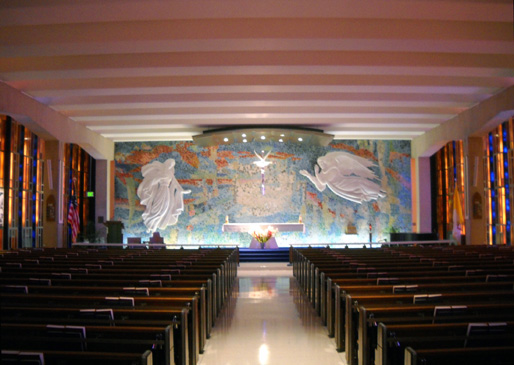
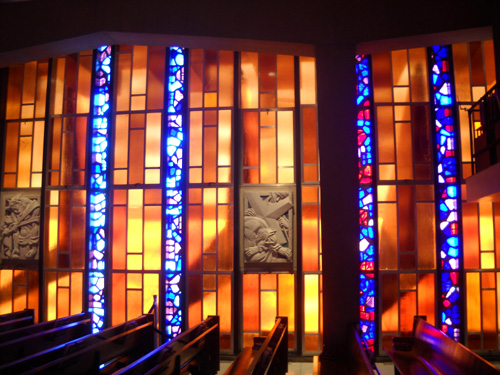
The Jewish synagogue, also on the lower level, is circular:
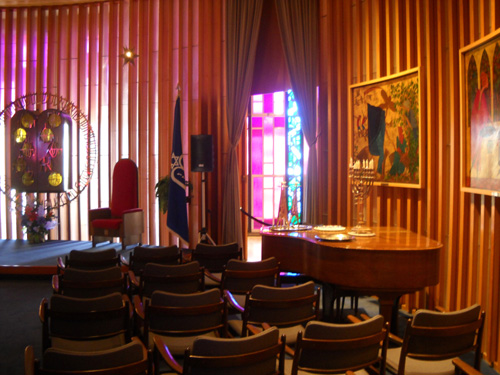
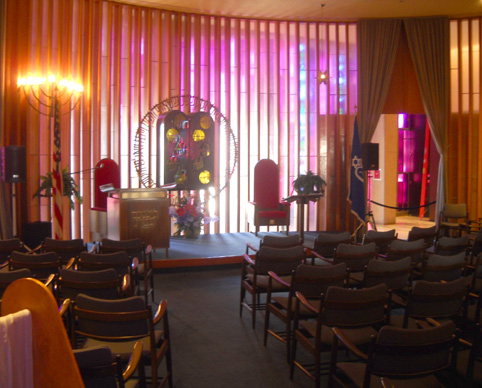
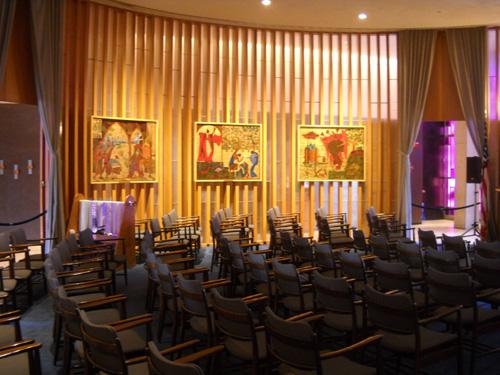
The small Buddhist sanctuary was added in 2007:
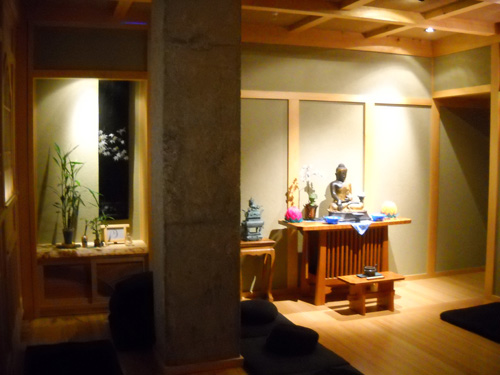
There are two more rooms below ground that are all-faiths rooms
used by other, smaller religious groups. We didn't see the
entrances for them.
You can read more about the architecture and interesting furnishings in the
chapel
here or
here .
THE 10TH AIR BASE WING
I mentioned at the beginning of this entry that the USAF Academy
is not just a university, it's also a military base that is set
up in a similar manner to other Air Force bases.
The 10th Air Base Wing employs more than 3,000 military,
civilian, and contract personnel who provide support activities
like law enforcement, force protection, civil engineering,
communications, logistics, financial management, a hospital and clinic,
the commissary and BX, and other services for a military
community of about 25,000 people.
THE A-10 WARTHOG DISPLAY
I've already got so many photos in this entry, I'll talk about
this in the Thunderbird entry coming soon.
PEREGRINE PINES FAMCAMP
We totally lucked out getting a reservation in this beautiful
campground when we called a couple weeks ago. The sites weren't
all full when we arrived on Sunday but most of them are now
-- graduation is tomorrow!
Set in one of many forested areas on the academy grounds, the
FamCamp is more like a spacious state park or national
forest campground more than any other military campground we've
been in. We love it!
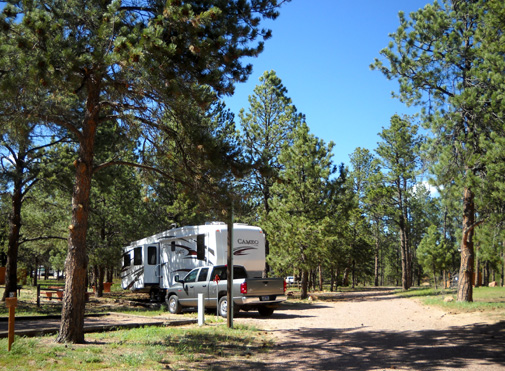
Can we just live here??
The joke about living here is pure fantasy, of course. Sure, the
weather is ideal this time of year and we've got everything we
could possibly want either on base, in Colorado Springs, or in
the nearby Pike's Peak region. But we'd have to deal with snow
during the winter (the campground elevation is 6,670 feet) and
we're, um, about forty-three years too old to be cadets!
In addition, military retirees and
families can stay in the campground for a maximum of only thirty days in the summer,
more from October to March. That's good for folks who aren't as
snow-phobic as us. We'll be leaving after
eleven days this time because Jim's signed up for another race on June 5
and we have other race and travel plans after that. We might
come back later this summer, though.
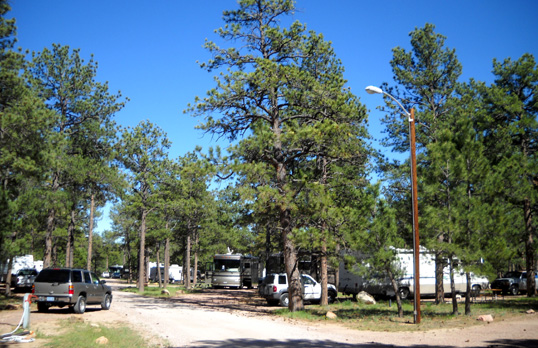
This loop is more full than ours is.
The campground has 106 sites, many of them pull-thrus for large
RVs. Most of the back-in sites are pretty big, too. There are a
lot of Class As here and we were very surprised to see three
other Cameo 5th wheel coaches! We've already talked to two of
the owners about their rigs. They are retired, sold their
houses, and travel in their Cameos full time.
All the RV sites have full hookups (water, 30- or 50-amp
electrical service, and sewers). When we made reservations the
only sites left that were long enough for our Cameo were 30-amp
back-ins. That works for us.
Sites close to the office have WiFi. We are fairly close, but the
connection is sporadic. There is no extra charge
for WiFi. We have good cell phone, internet broadband, and
TV reception, even without satellite or a cable hookup.
There are additional primitive
tent sites in two locations, four restrooms (at least two with
showers), a dump station, two laundry rooms (public washers and dryers
are cleaner and cheaper in military campgrounds than anywhere
else on earth!), a community room, two playgrounds, three picnic
pavilions, and lots of open space surrounding the campground.
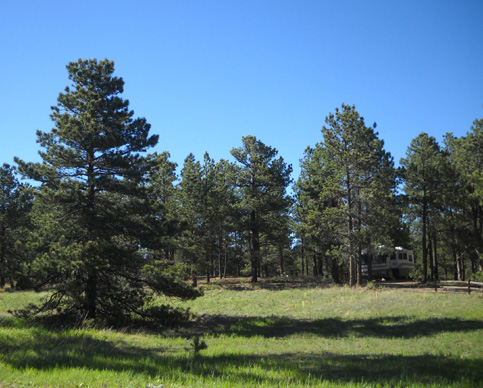
Field next to the campground that we walk
through to reach the Falcon Loop Trail
The campground is in such a natural area at the foot of the
Rockies, in fact, that visitors are warned about bears and
mountain lions! Every dumpster has special bear-proof latches to
prevent unwanted four-legged guests.
Campground costs are reasonable: $20/night in the spring
and summer months
for active duty and retired military personnel in either the
30-amp or 50-amp sites and $25 for sponsored guests. There are
no weekly or monthly rates.
We highly recommend this campground for military families. Just
make reservations early, especially around graduation time. For more
information about Peregrine Pines, click on this logo:
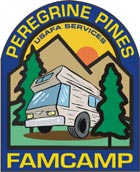
All the services that we need are either on base or nearby. We
have checked out the commissary and BX and gotten a mail drop at
the Post Office at the base mini mall. I-25 is right out
the north and south gates. WalMart, Sam's Club, Home
Depot, and every other conceivable Big Box store and specialty
stores are within two or three miles of the south gate.
Both the base and Colorado Springs are easy to navigate,
although easier done in some neighborhoods in your tow vehicle
or "toad" than in an RV. You wouldn't want to take a large RV
through Manitou Springs or Old Colorado City.
PLANES, TRAINS, AND AUTOMOBILES
Not everything is perfect here, however.
First, there are noisy trains close by.
Seems like there are trains that we can hear at 85% of the
camping spots we choose! A major train route runs north to south
between the base and I-25. It is very close to the eastern loop
in the campground. Thank goodness we ended up in the western
loop, about as far away from the trains as possible. We don't
notice them during the day, only in bed. My earplugs don't
completely block out the noise if I'm awake but the trains
haven't awakened me yet.
Second, there are noisy planes. No, not the ones that fly in and
out of the nearby base airfield. We rarely notice those. It's
those doggone Thunderbird air show planes!
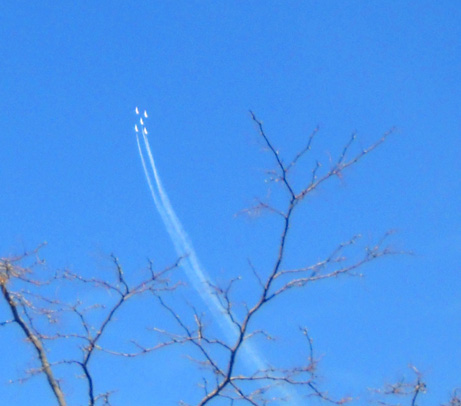
Five of the six Thunderbird planes during
today's air show practice
Just kidding. We are fascinated by them. They are here this
week, practicing for their much-anticipated flyover at the end
of cadet graduation tomorrow. Because their practice flight path
goes right over the campground, everyone in the
campground had to evacuate for several hours yesterday and
today.
Yesterday's practice was finally cancelled (after we'd vacated
the campground for three or four hours) because of high winds.
Today's practice went off as planned, and boy, did we enjoy the
show from another part of the base that wasn't off-limits! I'll
show more pictures of today's practice run and tomorrow's grand
finale in a subsequent entry.
And automobiles? No problem. Even though busy I-25 is
close, the trees in the campground have muffled any road noise
so far except the sirens responding to a large pile-up. Traffic
moves relatively slowly on base because of the 45 MPH speed
limit (and under).
There are scads of bicycles on base; the major roads have
wide bike lanes and I feel safer riding here than most roads.
Many of the cyclists come in from town to ride the streets and
trails on base for free. They just need ID to get through the
security gates.
Next entry: lucking out again -- tickets to
graduation!
Happy trails,
Sue
"Runtrails & Company" - Sue Norwood, Jim O'Neil,
and Cody the Ultra Lab
Previous
Next
© 2010 Sue Norwood and Jim O'Neil
